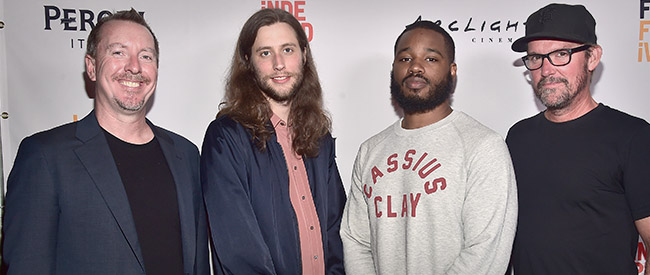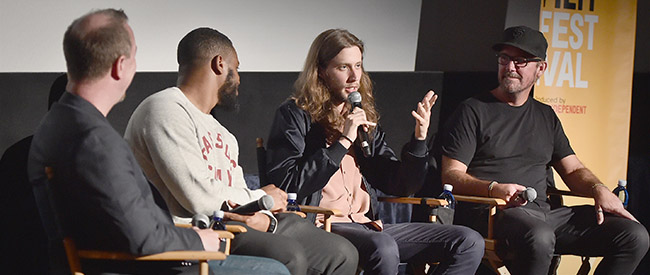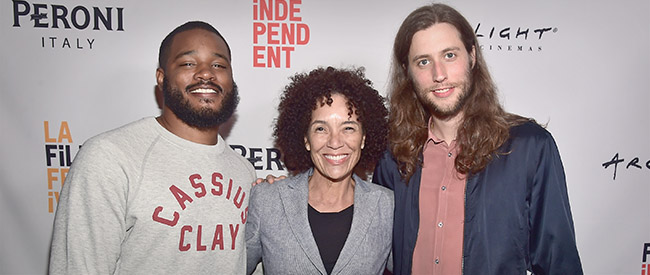Coogler recalled his first film classes at Sacramento State and how, in order to make a short film, he had to take a series of pre-requisite courses. One of those was a ProTools class. “I couldn’t really understand why,” he said. “At that time ProTools was something I associated with music. Everybody that I grew up with that was trying to be a rapper—they used ProTools.” Coogler explained how he and his classmates worked with the movie Highlander, changing the sound to “make it their own.” Different students would take the project in different directions—some making the sound realistic, others heavily stylized, others keeping it simple. “I realized in that class that sound is filmmaking,” he said. Coogler was joined on the panel by his Creed collaborators Ludwig Göransson and sound designer Steve Boedekker. The three broke down the components of building cinematic sound, saying: “It was a saying we used to have. People will forget bad lighting, pretty much everything. But they won’t forget bad sound.” The event was moderated Glen Kiser, director of the Dolby Institute, who asked the panelists how they each contributed to the audible aesthetic of Coogler’s films. To illustrate the process, they showed three clips: two from Creed, and one from Coogler’s critically acclaimed debut film, Fruitvale Station. The first clip was from Creed’s training montage. The music takes several stylistic turns throughout the scene as it intercuts between Michael B. Jordan’s Adonis Creed fight training, Sylvester Stallone’s Rocky Balboa battle with cancer and Adonis’s opponent preparations for the ring. It was one of the hardest scenes for Coogler and his editors to cut, and an equal challenge for Göransson to score. “The training montage is such a trope for these movies,” noted Kiser. “You can’t make Rocky without a training montage.” Göransson recalls writing around 40 minutes of music for that one scene alone, with changes to the cut demanding further composition. But ultimately, “the last six minutes are what we used,” he said. Boedekker added, “[Coogler] is always thinking about what the sound should be. The first time I heard the cue, I thought it was so amazing. I didn’t want to mess with it.” Boedekker didn’t want to overwhelm the music with the other sounds, so playing with the mix was key to finding the right balance. “I got lucky because I got to mix the music and the effects on this. So whichever one was going to tell the story the best at the time, we would try it.” For the second clip, separate layers of sound are peeled back and then return, to show how sound design is built within a scene. The clip featured a series of cuts from Creed’s final boxing match, starting with Adonis’s scoreless march to the ring and ending with the classic “Theme from Rocky,” finally kicking in as Adonis recovers his footing and fights on. “Ryan said he was scared of getting fired,” laughed Göransson. “I was even more scared of getting fired. So he sent me this scene and he said, ‘Write music for this.’ And I scored it. It’s like what we did for Fruitvale Station. At the end of the scene there was one moment when [Adonis] stands up and I was like, I’ll do something I know the studio is going to like. So I put in the Rocky theme.” Göransson eventually ended up reworking the score, but the Rocky cue stayed. Boedekker talked the audience through the post-production process. “It’s a culmination from all kinds of different points of view,” he said. “In the very beginning, [Adonis] is a kid watching TV, completely disconnected. In his fight in Tijuana we’re ringside—so we’re getting closer. The next fight we’re in the ring. In this scene, we’re all of them.” Fruitvale Station had a far more subtle, atmospheric score than Creed. The third clip was that of doomed lead Oscar Grant’s death. Played by Michael B. Jordan, the brutality of the San Francisco police toward Grant was punctuated by a brutal “punching” sound design and set to an evocative score seeping through the chaos. Watching the clip, Coogler said, “This is a tough movie for me. I haven’t seen it in a long time.” The sounds of Fruitvale are all too familiar to Coogler, augmented with the click and clatter of the ever-present elevated BART trains running through Oakland, Richmond, Hayward and San Leandro. “You constantly hear the sound of trains,” he said. “I didn’t notice how much I heard [them] until I moved to Los Angeles and didn’t hear it. It’s a bit ominous now, but before Oscar was killed it was a great comfort. It was a sound I associated with home. Now it’s something difficult for all of us.” An animated Q&A saw one 14-year-old actor and filmmaker ask Coogler for the chance to study under him. Coogler then offered some encouragement and advice: “Find people who you enjoy working with. I would like nothing more than to get a beer with these two dudes here to my left”—so that’s a no, then? Then they moved on to the next question, which happened to be from the question-asker’s brother—yet another young artist looking for tutelage. Taken aback, Coogler said, “I think I’m going to be in contact with your parents!” A reoccurring theme throughout the night was the importance of a collaborative spirit, and the importance of building creative relationships. “I met Steve at Skywalker Ranch,” said Coogler, who was at the facility with the support of the San Francisco Film Society, who he had connected with through the Sundance Lab while developing Fruitvale Station. They talked about collaborating, but it didn’t materialize just then. Luckily, it did for Creed. Göransson and Coogler met at USC, just three months after Göransson moved to the US from Stockholm. “He was living in a fraternity on campus,” said Coogler. “I was an international grad student,” said Göransson. “I felt like I was dumped into American Pie. I was in my little room trying to write music, and there were parties constantly outside. That’s where I scored Ryan’s first short”—Göransson has scored all of Coogler’s films since. The key ingredient, in the end, is to be open to what each person can bring to the table. “They told us [at USC] when you’re making a movie, you’re in good shape when you’re the dumbest dude on set.” Coogler is quick to credit his crew as highly skilled artists he’s lucky to command. Boedekker, an experienced Oscar-nominated artist, is quick to points out the value in this: “As you’re seeing right here, there’s no ego. That’s the thing. You don’t have to worry about being afraid of trying something, or experimenting, because there’s nothing slamming for it. And it just inspires everyone around to try to do there best because they want it for Ryan, really.” To this, Coogler blushed and the event concluded.
This year’s 2016 LA Film Festival is currently happening at the ArcLight Cinemas in Culver City as additional venues citywide through June 9. Buy your tickets to all of our great screenings and special events today. Click here for more information. To see our full lineup and Festival Guide, please visit our website, stay tuned to this blog and subscribe to our YouTube channel. Learn how to become a Member of Film Independent by clicking here.


